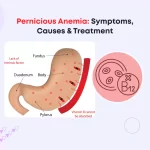
When is Low Platelet Count Dangerous?
If you experience prolonged bleeding from cuts and wounds, as well as an increased tendency to bruise easily even from minor bumps or knocks, red or purple spots on the skin, bleeding gums, nosebleeds, or blood in the urine or stool, you may be at the chance of developing thrombocytopenia where your platelet count is low.
Keep reading to know what causes a low platelet count, how it is diagnosed, and when it becomes dangerous. Also, get to know some tips on how to increase your platelet count if it is low. By the end of this post, you will have a better understanding of thrombocytopenia and when to seek medical attention for a low platelet count.
What Are Platelets?
Platelets are one of the major components in our blood that help to form clots and stop bleeding when we get injured. A low platelet count, also known as thrombocytopenia, can be a cause for concern, as it may lead to excessive bleeding and bruising. However, not all low platelet counts are dangerous. In fact, some people may have a naturally lower platelet count than others.
In severe cases, low platelet counts can lead to more serious symptoms such as excessive bleeding from the gums, prolonged or heavy menstrual periods, or, in rare cases, bleeding in the brain, which can cause headaches, changes in vision, or even unconsciousness. If you experience any of these symptoms, you must consult with your doctor or call us to determine the cause and appropriate treatment.
The Role Of Platelets In The Body
Platelets, also called thrombocytes, are vital for blood clotting and are produced in the bone marrow. When blood vessels are damaged, platelets rush to the site, forming clumps to seal the area and prevent excessive bleeding. They also release growth factors that aid in tissue repair by stimulating cell and blood vessel growth. Furthermore, platelets play a role in the immune response, interacting with other immune cells to combat infections. However, low platelet count (thrombocytopenia) can lead to impaired clotting, causing prolonged bleeding and an increased risk of hemorrhage.
What is the Normal Platelet Count?
The typical platelet count range for adults is 150,000 to 450,000 platelets per microliter of blood. A decrease in platelet count may suggest clotting disorders, while an increase may indicate a heightened risk of cancer. It’s important to note that the normal platelet range can vary based on age and specific medical conditions.
What Happens When You Have Low Platelet Count?
When the platelet count is low, the blood’s ability to clot effectively is compromised. This means that even minor injuries or internal bleeding can lead to prolonged bleeding or difficulty in stopping it. Symptoms of low platelet count may include excessive bruising, prolonged bleeding from cuts or wounds, nosebleeds, blood in urine or stools, and, in severe cases, spontaneous bleeding from the gums or internal organs.
It is important to note that the severity of symptoms may vary depending on the individual and the underlying cause of thrombocytopenia. While some individuals may experience mild symptoms or remain asymptomatic, others may face more severe complications. If you suspect a low platelet count or experience any concerning symptoms, it is essential to seek medical advice. Visit us for timely diagnosis and appropriate treatment to help manage the condition effectively and prevent potential complications associated with low platelet count.
What Is Considered A Low Platelet Count?
When the number of platelets in the blood drops below normal levels, it can have serious implications for one’s health. But what exactly is considered a low platelet count?
A low platelet count, or thrombocytopenia, is defined as having fewer than 150,000 platelets per microliter of blood. However, the severity of thrombocytopenia varies depending on the cause and individual circumstances. In some cases, even a slight decrease in platelet count can lead to significant health complications.
Thrombocytopenia is often categorized by severity:
- Mild: Platelet counts range from 100,000 to 150,000 per microliter of blood.
- Moderate: Platelet counts range from 50,000 to 100,000.
- Severe: Platelet counts are below 50,000.
It’s important to note that platelet counts alone may not predict symptoms or bleeding risk. Platelet function and overall health also play roles. Someone with a slightly low platelet count and good health may not experience symptoms. In contrast, others with health issues or certain medications may be more prone to bleeding despite a higher platelet count.
Common Causes Of Low Platelet Count
There are several common causes of low platelet count, also known as thrombocytopenia.
- Bone marrow disorders
- Autoimmune disorders
- Medications
- Viral infections
- Vitamin deficiencies
It’s important to note that while these causes can contribute to low platelet count, the severity and danger of thrombocytopenia depend on various factors.
When Does A Low Platelet Count Become Dangerous?
A low platelet count (thrombocytopenia) becomes dangerous when it leads to symptoms such as:
- Bleeding from the mouth or gums
- Nosebleeds
- Bruises on the arms or legs, with or without an injury
- Red or purple spots on the skin
- Brown or red urine
- Bloody stool
- Blood in the mucus
- Vomiting blood
- Prolonged or heavy menstrual flow
- Persistent headache
- Blurred or double vision
- Abdominal pain
Treatment For Low Platelet Count
Treatment for low platelet count (thrombocytopenia) varies based on its cause and severity:
- For mild cases without symptoms, regular monitoring through blood tests may be sufficient.
- Treating infections or autoimmune disorders can help improve platelet counts.
- Severe cases may require medications to stimulate platelet production or transfusions to raise platelet counts quickly.
- For long-term or severe cases, treatments like immune-suppressing medications or splenectomy (spleen removal) may be considered.
Tips To Maintain A Healthy Platelet Count
- Maintaining a healthy platelet count is crucial for overall well-being and preventing potential health risks. While some individuals may naturally have lower platelet counts than others, several preventive measures can be taken to ensure optimal platelet levels.
- Maintain a balanced diet rich in vitamins and minerals like iron, folate, and vitamin K to support healthy platelet production. Include foods like leafy greens, legumes, lean proteins, and citrus fruits in your meals.
- Regular exercise, at least 30 minutes most days of the week, improves blood circulation and stimulates platelet production.
- Avoid excessive alcohol and quit smoking, as they can negatively affect platelet production and function.
- Manage stress through techniques like meditation, yoga, or hobbies, as chronic stress can disrupt platelet production.
- Regular check-ups and consultations with a healthcare professional are crucial for monitoring platelet levels and detecting any abnormalities early on.
When To Seek Medical Attention?
While a slightly low platelet count may not immediately pose a danger, it’s crucial to monitor and address significant fluctuations. Early detection allows for timely intervention, preventing potential complications. If you notice symptoms like excessive bruising, prolonged bleeding, or other signs of abnormal bleeding, seek medical attention promptly. Additionally, if you have a known condition that affects platelet levels or if you’re undergoing treatments that can impact platelet counts, regular monitoring and communication with your healthcare provider are essential.








